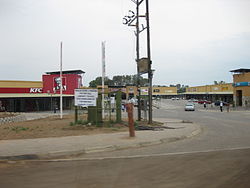Molepolole
| Molepolole | |
|---|---|
| Village | |

Mafenyatlala mall in Molepolole,
|
|
| Coordinates: 24°24′24″S 25°29′42″E / 24.40667°S 25.49500°ECoordinates: 24°24′24″S 25°29′42″E / 24.40667°S 25.49500°E | |
| Country |
|
| District | Kweneng District |
| Sub-district | Molepolole |
| Elevation | 1,189 m (3,901 ft) |
| Population (2011) | |
| • Total | 67,598 |
| Time zone | Central Africa Time (UTC+2) |
| • Summer (DST) | not observed (UTC+2) |
| ISO 3166 code | BW-KW |
| Climate | BSh |
Molepolole is a village in Botswana. It lies in the south east of the country. The people who reside in Molepolole are the Bakwena, who are one of the eight major tribes in Botswana. The Bakwena chief was among the three chiefs who went to England to seek protection from the British in the colonial era. Molepolole serves as the capital of the Bakwena. It was named after the Molepolole river.
It is one of the largest traditional villages in Africa with a population of over 69,789 people as of 2008. It lies 50 kilometres west of the national capital Gaborone, and acts as gateway for exploring the Kalahari Desert.
It has a large traditional court (or kgotla) and is the location of the Scottish Livingstone Hospital, one of the nation's largest.
Ntsweng was the capital of Bakwena before they moved to Molepolole. Ntsweng is a historic site located a few kilometers southeast of Molepolole. The area was first occupied by Bakwena, led by Sechele I (ruled 1829–92), in 1864. It was abandoned in 1937 when Bakwena were forced to move to Molepolole by Kgari II, assisted by the colonial administrators. Ntsweng today consists of a large area covered with traces of occupation. Most notable are the patterns of stones laid on their edges to form house foundations which are still visible on the surface. There are also the ruins of what used to be Sebele II's office which is at present referred to as Mmakgosi's house. The ruins of that building are situated next to an area which used to be the royal kraal at Ntsweng but is now the royal cemetery. Several clusters of ruins seem to represent different wards. Analyses of the settlement layout and soil samples suggest cattle were often kept in the center of each ward. This seems to follow the "central cattle pattern", a conceptual model for the organization of settlements among southern Bantu, where the central placement of the kraal reflects the central role of cattle in the culture and ideology of the people.
The archaeological site at Ntsweng in Molepololole showing the ruins of the old settlement.
The ruins of Bakwena Tribal Office at Ntsweng.
Bakwena Royal Cemetery, which used to be a royal kraal at Ntsweng.
The Botswana Prison Service (BPS) operates the Molepolole Prison.
...
Wikipedia

